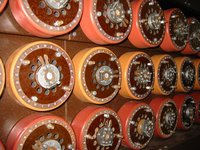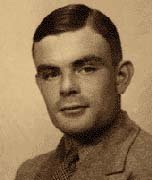Alan Turing
Alan Mathison Turing (June 23, 1912 - June 7, 1954) was a British mathematician and cryptographer, and is considered to be one of the fathers of modern computer science. He provided an influential formalisation of the concept of algorithm and computation: the Turing machine. He formulated the now widely accepted 'Turing' version of the Church-Turing thesis, namely that any practical computing model has either the equivalent or a subset of the capabilities of a Turing machine. During World War II he was the director of the Naval Engima Hut at Bletchley Park for some time and remained throughout the War the chief cryptanalyst for the Naval Enigma effort. After the war, he designed one of the earliest electronic programmable digital computers at the National Physical Laboratory and, shortly thereafter, actually built another early machine at the Universtiy of Manchester. He also, amongst many other things, made significant and characteristically provocative contributions to the discussion "Can machines think?"
Childhood and youth
He was born in Paddington to Civil Service officer Julius Mathison Turing and his wife Ethel (née Stoney). His father's Indian Civil Service commission was still active, and during Turing's childhood years his father travelled between England and India, leaving his family to stay with friends in England due to concerns over the dangers of the British colony. Very early in life, Turing early showed signs of the genius he was to display more prominently later. He is said to have taught himself to read in three weeks, and to have shown an early affinity for numbers and puzzles.His parents enrolled him at St. Michael's, a day school, at six years of age. The headmistress recognised his genius early on, as did many of his subsequent educators at Marlborough College (a public school). At Marlborough, he first reported having problems with bullies. He went on to the Sherborne boarding school at 13, where his first day was actually covered in the local press. There was a general strike in England, and Turing rode his bike sixty miles to school, stopping overnight at an inn.
Turing's natural inclination toward the sciences did not earn him respect with the teachers and administrators at Sherborne, whose definition of education emphasised the classics rather than science. But despite this, Turing continued to show remarkable ability in the studies he loved, solving advanced (for his age) problems in 1927 without having even studied elementary calculus.
In 1928, Turing encountered Albert Einstein's work, and grasped it at a mere sixteen years of age, even extrapolating Einstein's Law of Motion from a text in which it was never made explicit.
College and his work on computability
Due to his unwillingness to work as hard on his classical studies as on science and mathematics, Turing failed his final examinations several times, and went on to the college of his second choice, King's College, Cambridge, rather than his first choice, Trinity. He studied under G. H. Hardy, a well respected mathematician who held the Sadleirian Chair at Cambridge, then a centre for mathematical research and study, from 1931 - 1934. In 1935 he was elected a Fellow at King's College.In his monumental paper "On Computable Numbers, with an Application to the Entscheidungsproblem" (1936), he reformulated Kurt Gödel's 1931 results on the limits of proof and computation, substituting Gödel's universal arithmetics-based formal language by what are now called Turing machines, formal and simple devices. He proved that such a machine would be capable of performing any conceivable mathematical problem if it were representable as an algorithm, even if no actual Turing machine would be likely to have practical applications, being much slower than alternatives. Turing machines are to this day the central object of study in computational theory. He went on to prove that there was no solution to the Entscheidungsproblem by first showing that the halting problem for Turing machines is unsolvable: it is not possible to algorithmically decide whether a given Turing machine will ever halt. While his proof was published subsequent to Alonzo Church's equivalent proof in respect to his lambda calculus, Turing's work is considerably more accessible and intuitive. It was also novel in its notion of a "Universal (Turing) Machine", the idea that such a machine could perform the tasks of any other machine. The paper also introduces the notion of definable numbers.
Most of 1937 and 1938 he spent at Princeton University, studying under Alonzo Church. In 1938 he obtained his Ph.D. from Princeton; his dissertation introduced the notion of hypercomputation where Turing machines are augmented with so-called oracles, allowing a study of problems that cannot be solved algorithmically.
Back in Cambridge in 1939, he attended lectures by Ludwig Wittgenstein about the foundations of mathematics. The two argued and disagreed vehemently, with Turing defending formalism and Wittgenstein arguing that mathematics is overvalued and does not discover any absolute truths.
Cryptanalysis (code breaking)

Replica of a bombe machine
Turing's work on breaking the Enigma cypher was kept secret until the 1970s; not even his close friends knew about it.
Work on early computers; the Turing Test
From 1945 to 1948 he was at the National Physical Laboratory, where he worked on the design of ACE (Automatic Computing Engine). In 1949 he became Deputy Director of the computing laboratory at the University of Manchester, and worked on software for one of the earliest true computers &mdash the Manchester Mark I. During this time he continued to do more abstract work, and in "Computing machinery and intelligence" (Mind, October 1950), Turing tackled the problem of artificial intelligence, and proposed an experiment now known as the Turing test, an attempt to define a standard for a machine to be called "sentient".In 1952 Turing wrote a chess program. Lacking a computer powerful enough to execute it, he himself simulated the computer, taking about half an hour per move. One game was recorded; the program lost to a colleague of Turing.
Persecution for homosexuality, and Turing's death
Persecution of Turing for his homosexuality crippled his career. In 1952, his male lover helped an accomplice to break into Turing's house and commit larceny. Turing went to the police to report the crime. As a result of the police investigation, a 19-year-old man was said to have sexual relationship with him and Turing was charged with "gross indecency and sexual perversion" (see sodomy law). He unapologetically offered no defence, and was convicted. Following the well-publicised trial, he was given a choice between incarceration and libido-reducing hormonal treatment. He chose the hormone injections, which lasted for a year, with side effects including the development of breasts during that period. In 1954, he died of poisoning after eating a cyanide-laced apple. Most believe that his death was intentional, and the death was ruled a suicide. His mother, however, strenuously argued that the ingestion was accidental due to his careless storage of laboratory chemicals.
Quotes
"We can only see a short distance ahead, but we can see plenty there that needs to be done." --From his paper on the Turing test(1943, New York: the Bell Labs Cafeteria) His high pitched voice already stood out above the general murmur of well-behaved junior executives grooming themselves for promotion within the Bell corporation. Then he was suddenly heard to say: "No, I'm not interested in developing a powerful brain. All I'm after is just a mediocre brain, something like the President of the American Telephone and Telegraph Company." --Quoted in A Hodges - Alan Turing: the Enigma of Intelligence, (London 1983) 251.
"Science is a differential equation. Religion is a boundary condition." --Quoted in J D Barrow - Theories of everything
"...I believe that at the end of the century the use of words and general educated opinion will have altered so much that one will be able to speak of machines thinking without expecting to be contradicted."
"Mathematical reasoning may be regarded rather schematically as the exercise of a combination of two facilities, which we may call intuition and ingenuity."
"In the time of Galileo it was argued that the texts, 'And the sun stood still ... and hasted not to go down about a whole day' (Joshua x. 13) and 'He laid the foundations of the earth, that it should not move at any time' (Psalm cv. 5) were an adequate refutation of the Copernican theory." --Computing Machinery and Intelligence, Mind 59 (1950), 443.

